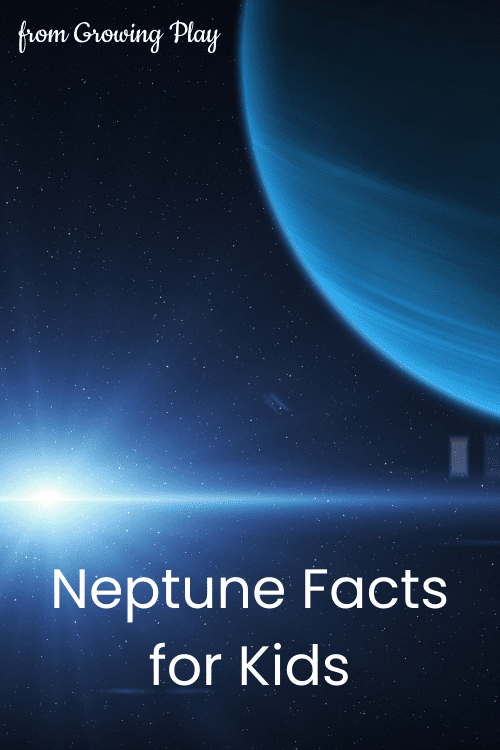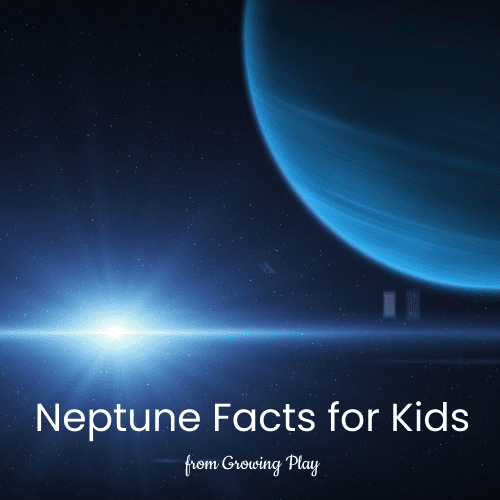Neptune Facts for Kids

Do you love outer space? Can you name all the planets? There are eight planets in our solar system: Mercury, Venus, Earth, Mars, Jupiter, Saturn, Uranus, and Neptune. Today, we are going to learn all about Neptune with these Neptune facts for kids.
From its position in the solar system to its massive size and weight, we will cover it all so sit back and get ready to learn! You never know what you may discover.
When Was Neptune Discovered?
The planet Neptune is not visible to the naked eye and did you know it is the only planet in the Solar System found by mathematical predictions and mathematical calculations rather than by empirical observation. Unexpected changes in Uranus’s orbit led Alexis Bouvard to deduce that its orbit was subject to gravitational perturbation by an unknown planet. The new planet, which later become known as Neptune was subsequently observed on 23 September 1846 by German Astronomer Johann Gottfried Galle within a degree of the predicted position.
Its largest moon, Triton, was discovered shortly thereafter, though none of the planet’s remaining known 13 moons were located telescopically until the 20th century.
Neptune Facts for Kids – Neptune’s Moons
Neptune has 13 known moons: Naiad, Thalassa, Despina, Galatea, Larissa, Proteus, Triton, Nereid, Halimede, Psamathe, Sao, Laomedeia, and Neso.
How Did Neptune Get its Name?
Neptune is named after the Roman god of the sea.
Its astronomical symbol is ♆, a stylised version of the god Neptune’s trident. Can you draw Neptune’s astronomical symbol?
Neptune Facts for Kids – Neptune as a Gas Giant and Ice Giant
Neptune is one of the four gas giants in the Solar System, along with Jupiter, Saturn, and Uranus. These planets are much larger than Earth and consist mostly of hydrogen and helium.
The interiors of all four gas giants are primarily composed of ice and rock.
Uranus and Neptune are sometimes called ice giants because they have more ice particles (such as water, methane ice, and ammonia) in their composition than the other gas giants Jupiter and Saturn, which are mostly composed of hydrogen and helium.
Neptune’s Position in the Solar System
Neptune is the eighth planet from the sun, making it the most distant planet in our solar system. Previously, Pluto was believed to be the furthest planet but it has since been considered a dwarf planet.
Neptune orbits the Sun once every 164.8 earth years at an average distance of 30.1 astronomical units (4.50×10^9 km).
Neptune Facts for Kids – The Size of Neptune
The planet Neptune is the fourth largest planet by diameter and the third largest planet by mass.
Neptune is 17 times the size of Earth in terms of mass and is slightly more massive than its near-twin Uranus, which has 15 times a greater mass than Earth.
Characteristics of Neptune
The planet’s northerly pole has a dark featureless patch corresponding to “Battlecrater”, which is surrounded by bright material tagged as “Spiral Q”.
Neptune is the windiest planet with the strongest winds of any planet. The fastest winds on Neptune can reach 2,100 km/h (1,300 mph). Wow, those are some strong winds!
Neptune has only one-twentieth the amount of sunlight that Earth receives from the Sun. Can you imagine how dark the surface of Neptune is?
Neptune Facts for Kids – Neptune and the Voyager Spacecraft
Neptune has been visited by only one spacecraft, Voyager 2, which flew by the planet on August 25th, 1989. The flyby revealed that Neptune’s atmosphere contains large amounts of methane and that its south pole is much colder than its north pole.
Neptune has an extremely faint and tenuous ring system, discovered in 1989 by Voyager 2.
Neptune’s Atmosphere
Sixteen nebulae have been discovered in Neptune’s atmosphere.
Neptune’s atmosphere is made up of hydrogen (80%), helium (19%), and methane (1%). The methane in Neptune’s atmosphere absorbs red light, making the planet appear to be a beautiful blue color. This is how Neptune got its nickname of the Blue Planet.
The planet Neptune has a faint magnetosphere.
Neptune Facts for Kids – The Temperature of Neptune
The average temperature on Neptune is -214 degrees Celsius (-353 degrees Fahrenheit). Wow, those are some pretty brutal temperatures.
Neptune’s moon Triton is known for its extreme cold temperatures, even colder than those on the surface of Neptune. The coldest temperature ever recorded in the Solar System was -235 degrees Celsius (-391 degrees Fahrenheit) on Neptune’s moon Triton.
Let’s Summarize Neptune Facts for Kids
What new facts did you learn about the planet Neptune? Maybe you learned about Neptune’s moon Triton and how cold the surface of Triton can be. Did you know it was responsible for the coldest temperature ever recorded in the Solar System? And did you know Neptune was discovered based on mathematical calculations when it appeared there was an outside force changing the orbit of the neighboring planet Uranus? How about that Neptune was only visited once by spacecraft? Nasa’s Voyager 2 flew by the planet in 1989 noting observations related to Neptune’s atmosphere and ring system.
What more do you want to learn about the planet Neptune? There are so many hidden mysteries on the surface of Neptune and in our Solar System in general. What do you think some of them are? Would you want to be the astronaut who discovers them? I’m perfectly content watching from my couch at home, but kudos to you if you are brave enough to travel into space. Let us know if you do!
WANT MORE FUN FACTS FOR KIDS?
Check out these fun facts for kids here and browse all the other topics at the bottom of the post.
Read more Solar System Facts for Kids here.



